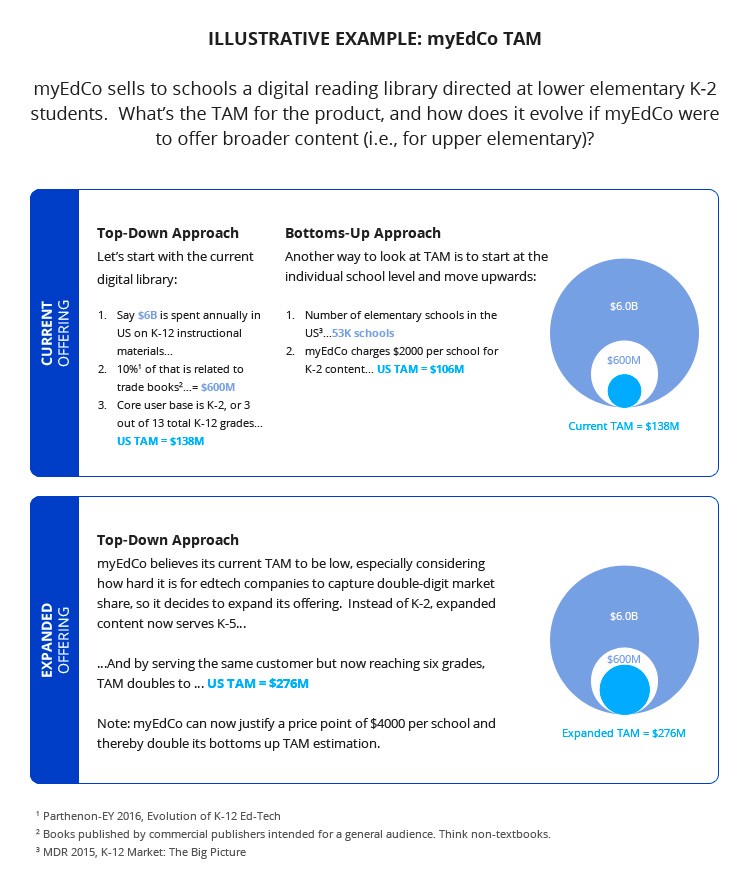
by Esteban Sosnik
Dear Esteban,
I’m working on an idea for an edtech company — very early stage. I’ve identified a compelling pain point, but I’m feeling a little insecure about the potential size of my opportunity. How do I know if my TAM is big enough?
— Sizing Up
Dear Sizing Up,
This is a great question, especially because investors can sometimes seem to display cognitive dissonance when it comes to TAM.
Your TAM, or “Total Addressable Market,” is a dollar figure representing the total amount of money spent on the problem your product or service addresses. The term is often a proxy for how big the revenue opportunity is for your company. The bigger the TAM, the bigger the opportunity. VCs, of course, like big TAMs.
At the same time, it’s common for early-stage entrepreneurs to hear VCs encourage them to stay laser-focused on solving a narrow problem. As a resource-limited startup, you need to scope and focus on successfully solving one pain-point for your customers in order to overdeliver in customer satisfaction. The thinking goes: start by doing one thing well with your limited time and capital, and then expand.
However, focusing on a niche need might lead you to build something hyper-specific, like a science app for 6th-grade English language learners. And there’s the contradiction: the more focused you are, the smaller your TAM.
In my view, your initial TAM isn’t as important as you might believe, though having a perspective and plan on how to grow your TAM is. Initially your focus should be on becoming the leader in your particular niche and building customer loyalty, even if addressing a small market opportunity. After you’ve found a product-market fit and maximize your revenue relative to your initial TAM, you can then start focusing on growing your TAM. But how?
At that point, there are two main ways to expand your potential revenue opportunity. One is by increasing your revenue per customer with new offerings, and the other is by finding new customers in adjacent markets.
Grow With the Same Customer
The first approach is to expand your core offering to satisfy more of your current customers’ needs, thereby increasing your total revenue potential per customer. One of the best examples of this is Achieve3000, which aims to accelerate PreK-12 literacy by providing content adapted to students’ individual Lexile reading levels. The company initially focused on ELA content, but eventually expanded its offering to include science content, all the while reinforcing key literacy needs in each of these subjects. The aim? The same customers continue to use Achieve3000 content, but they use it more extensively: not in just ELA classes but in other subject areas as well. Hence, they arguably are willing to pay a higher price per subscription. In this way, Achieve3000 expanded its TAM without needing to reach an entirely new customer base.
To demonstrate this approach another way:
Grow with the Same Product
The second approach to growing your TAM is to repurpose your current core product offering for a new customer or use case. Piper is a tool where kids get exposure to the principles of electronics, coding, and other STEM concepts by building a physical computer to play a Minecraft-style game. Initially, the company focused on selling to parents, and later they began selling to schools as well. If you can reach into adjacent markets, like Piper has done, that is a great way to expand your TAM without needing to develop an entirely new product.
Addressing corporate or international markets is another way to expand your TAM using the same basic product offering. For example, WriteLab, an application that provides students feedback on writing elements such as spelling, clarity, logic, and grammar, originally focused on the domestic market (mostly university students) but more recently took its offering as well into the TOEFL market serving foreign students.
What’s important here is that Piper and WriteLab don’t need to reinvent their product as they are able to address a new customer type. New customer bases will definitely imply changes in distribution and sometimes business model, but the point is that you are able to leverage an existing product to access them.
It is worth noting that successful companies will do a little bit of both as they grow — expanding their TAM by going deeper with current customers while simultaneously reaching adjacent markets with their core product. This is a complex strategy that should not be attempted until your foundational market is well served. One example here is EverFi, a digital learning platform aimed at certifying learners in “critical skills that real life demands.” Founded in 2007, EverFi expanded across the K-12, higher education, and corporate markets with its core offerings (new customers, similar offerings). During this time, it also expanded from its financial literacy roots into topics such as African-American History (same customers, new offerings). EverFi’s successful model recently helped the company raise a $190 million round.
TAM is particularly relevant for investors in edtech because the market is not infinite. Just about every human on Earth can use a product like Google Search (everyone looks for new information) and any company can use a CRM system like Salesforce (every company needs new and happy customers), but only a limited number of eight-year-olds will be learning algebra each year.
However, don’t think of your TAM as a fixed number, written in stone the day you start your company. Rather, strategize about how you can evolve and expand your TAM as your company grows. Additionally, when deciding which TAM to include in pitch decks — the product you have today or the potential TAM that includes adjacent markets and new offerings — include both TAMs to show your current focus as well as upside potential. Hopefully this post gives you some ideas about how you can do that.


